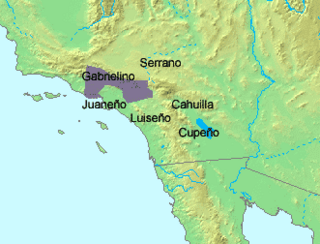Remove ads
The Tongva language (also known as Gabrielino or Gabrieleño) is an extinct[1] Uto-Aztecan language formerly spoken by the Tongva, a Native American people who have lived in and around modern day Los Angeles for centuries. It has not been a language of everyday conversation since the 1940s. The Gabrielino people now speak English but a few are attempting to revive their language by using it in everyday conversation and ceremonial contexts. Presently, Gabrielino is also being used in language revitalization classes and in some public discussion regarding religious and environmental issues.[2] Tongva is closely related to Serrano.[3] The names of several cities and neighborhoods in Southern California are of Tongva origin, and include Pacoima, Tujunga, Topanga, Azusa, Cahuenga in Cahuenga Pass and Cucamonga in Rancho Cucamonga.
| Tongva | |
|---|---|
| Gabrielino, Gabrieleño | |
| eyooshiraaw | |
| Native to | Southern California, United States |
| Region | Los Angeles, Santa Catalina Island |
| Ethnicity | Tongva |
| Extinct | ca. 1900 |
| Revival | since 2000s |
| Language codes | |
| ISO 639-3 | xgf |
xgf | |
| Glottolog | tong1329 |
 | |
The last fluent native speakers of Tongva lived in the early 20th century. The language is primarily documented in the unpublished field notes of John Peabody Harrington made during that time. The "J.P. Harrington Project", developed by The Smithsonian through University of California, Davis, approximately 6,000 pages of his notes on the Tongva language, were coded for documentation by a Tongva member, who took three years to accomplish the task. Alleged native speakers of Tongva who have died as late as in the 1970s have not been verified as having been fluent speakers.
The dwarf planet 50000 Quaoar was named after the Tongva creator god.[4]
Remove ads
The Gabrielino language is a subgroup of Takic, a subfamily of Uto-Aztecan, which is usually divided into three subgoups: Serrano-Kitanemuk, Gabrielino (including the Fernandeño dialect) and Cupan.[3] As of 2012, members of the contemporary Tongva (Gabrieleño) tribal council are attempting to revive the language, by making use of written vocabularies, by comparison to better attested members of the Takic group to which Tongva belonged, and by offering classes.[5]
In 2004, Pamela Munro, now UCLA emeritus professor of linguistics, was asked to serve as a linguistic mentor to Tongva people who wanted to learn about their language at the Breath of Life Workshop, a biennial event in Berkeley staged by the Advocates for Indigenous California Language Survival.[6] Since then, she has taught monthly Tongva language classes in which adults and children practice pronunciation, master the use of grammatical particles, sing songs and play word games. She calls her work "a reclamation effort" for the language.[7] Munro has compiled a Tongva dictionary of over 1,000 words, and also maintains a Tongva language Facebook page to which she posts Tongva words, phrases and songs.[8] Munro says there are no audio recordings of people speaking the Tongva language, but that there are a few scratched wax cylinder recordings of Tongva songs.[6][9]
Remove ads

Consonants
The following is a list of the consonants and vowels of the Tongva language as used by the Tongva Language Committee, based on linguist Pamela Munro's interpretation of the fieldnotes of J. P. Harrington.[11] In parentheses is the spelling of the specific sound. There are multiple orthographies for the Tongva language.
Consonants /b d f ɡ/ are used in loanwords.[11]
Vowels
Remove ads
Tongva is an agglutinative language, where words use suffixes and multiple morphemes for a variety of purposes.
Collected by C. Hart Merriam (1903)[12]
(Merriam refers to them as the Tongvā)
- Numbers
- Po-koo
- Wěh-hā
- Pah-hā
- Wah-chah
- Mah-har
- Pah-vah-hā
- Wah-chah-kav-e-ah
- Wa-ha's-wah-chah
- Mah-ha'hr-kav-e-ah
- Wa-hās-mah-hah'r
- Wa-hā's-mah-hah'r-koi-po-koo
- Wa-hā's-mah-hah'r-koi-wěh-hā
- grizzly bear
- hoó-nahr
- hoon-nah (subject)
- hoon-rah (object)
- black bear
- pí-yah-hó-naht
Collected by Dr. Oscar Loew (1875)[12]
- Numbers
- pu-guʼ
- ve-heʼ
- paʼ-hi
- va-tchaʼ
- mahaʼr
- pa-vaʼhe
- vatchaʼ-kabyaʼ
- vehesh-vatchaʼ
- mahar-kabyaʼ
- vehes-mahar
- puku-hurura
- vehe-hurura
- bear
- unar
Collected by Alexander Taylor (1860)[12]
- Numbers
- po-koo
- wa-hay
- pa-hey
- wat-sa
- mahar
- pawahe
- wat-sa-kabiya
- wa-hish-watchsa
- mahar-cabearka
- wa-hish-mar
Taylor claims "they do not count farther than ten"
Collected by Charles Wilkes, USN (1838-1842)[12]
- Numbers
- pukū
- wehē
- pāhe
- watsā
- bear
- hundr
Other sources
- desert fox: erow[13]
- Pacoima = from the root word Pako enter, meaning the entrance[citation needed]
- Tujunga = from the root word old woman tux'uu[citation needed] Tujunga means Mountains of Health according to long-time residents.
- Azusa = from the word -shuuk 'Ashuuksanga = his grandmother[citation needed]
The Lord's Prayer[11]
The Lord's Prayer is called ʼEyoonak in Tongva. The following text was derived from old Mission records.
ʼEyoonak
ʼEyoonak, ʼeyooken tokuupangaʼe xaa;
hoyuuykoy motwaanyan;
moxariin mokiimen tokuupra;
maay moʼwiishme meyii ʼooxor ʼeyaa tokuupar.Hamaare, ʼeyooneʼ maxaareʼ ʼwee taamet,
koy ʼoovonreʼ ʼeyoomamaayntar momoohaysh, miyii ʼeyaare
'oovonax 'eyoohiino 'eyooyha';
koy xaareʼ maayn ʼiitam momoohaysh,
koy xaa mohuuʼesh.
ʼWee meneeʼ xaaʼe.
Toponymy
The table below gives the names of various missions in the Tongva language.[14]
| English | Tongva |
|---|---|
| Los Angeles | Yaa |
| San Bernardino | Wa'aach |
| San Gabriel | Shevaa |
| San Pedro | Chaaw |
| Santa Ana | Hotuuk |
| Santa Monica | Kecheek |
| Santa Catalina | Pemu |
Remove ads
Remove ads
Wikiwand in your browser!
Seamless Wikipedia browsing. On steroids.
Every time you click a link to Wikipedia, Wiktionary or Wikiquote in your browser's search results, it will show the modern Wikiwand interface.
Wikiwand extension is a five stars, simple, with minimum permission required to keep your browsing private, safe and transparent.
Remove ads